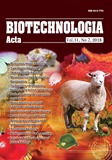ISSN 2410-7751 (Print)
ISSN 2410-776X (Online)

"Biotechnologia Acta" V. 11, No 2, 2018
https://doi.org/10.15407/biotech11.02.023
Р. 23-29, Bibliography 12, English
Universal Decimal Classification: 004:591.5:612:616-006
T. O. Chudina 1, 2, V. A. Skoryk 3, E. I. Legach 4
1Palladin Institute of Biochemistry of the National Academy of Sciences of Ukraine, Kyiv
2 ESC ‘Institute of Biology and Medicine’ Taras Shevchenko National University of Kyiv, Ukraine
3NanoMedTech LLC, Kiev, Ukraine
4 Institute for Problems of Cryobiology and Cryomedicine of the National Academy of Sciences of Ukraine, Kharkiv
The aim of the study was to synthesize poly(D,L-lactide-co-glycolide) particles — PLGA and obtain their complexes with a non-toxic diphtheria toxin recombinant fragment subunit B fused with enhanced green fluorescent protein EGFP-SubB; to characterize the main physical and chemical properties of the resulting complexes.
Two types of the diptheria toxoid loaded PLGA microparticles were obtained: particles with immobilized diphtheria toxoid (PLGA 1) and particles with encapsulated (PLGA) diphtheria toxoid (PLGA 2). Micropartcles obtaines were characterized for antigen loading, particle size, polydispersity index and in vitro antigen release.
Key words: diphtheria toxoid, poly (lactic-co-glycolic-acid) microparticles.
© Palladin Institute of Biochemistry of National Academy of Sciences of Ukraine, 2018
References
1. Labyntsev A. J., Korotkevych N. V., Manoil ov K. J., Kaberniuk A. A., Kolybo D. V., Komisarenko S. V. Recombinant Fluorescent Models for Studying the Diphtheria Toxin. J. Bioorg. Chem. 2014, 40 (4), 433–442, doi: 10.7868/ S0132342314040083.
2. Freeman V. J. Morse I. U. Further observations on the change to virulence of bacteriophage-infected a virulent strains of Corynebacterium diphtheria. J. Bacteriol. 1952, 63 (3), 407–414.
3. McEvoy P., Polotsky Y., Tzinserling V. A., Yakovlev A. A. The pathology of diphtheria. J. Infect. Dis. 2000, 181 (1), 116–20.
4. Collier R. J. Understanding the mode of action of diphtheria toxin: a perspective on progress during the 20th century. Toxicon. 2001, 39, 1793–803. https://doi.org/10.1016/S0041-0101(01)00165-9
5. Chudina T. O., Labintsev A. J., Romaniuk S. I., Kolybo D. V., Komisarenko S. V. Changes in proHB-EG F expression after functional activation of the immune system cells. Ukr. Biochem. J. 2017, 89 (6), 33–40. doi: 10.15407/ ubj89.06.031.
6. Adler N. R., Mahony A., Friedman N. D. Diphther ia: forgotten, but not gone. Inter. Med. J. 2013, 43 (2), 206-210. https://doi.org/10.1111/imj.12049
7. Couvreur P. Nanoparticles in drug delivery: past, present and future. Adv. Drug. Deliv. Rev. 2013, 65 (1), 21–23. https://doi.org/10.1016/j.addr.2012.04.010
8. Hirenkumar K. Makadia, Steven J. Siegel. Poly Lactic-co-Glycolic Acid (PLGA) as Biodegradable Controlled Drug Delivery Carrier. Polymers (Basel). 2011, 3 (3), 1377– 1397. https://doi.org/10.3390/polym3031377
9. Kaberniuk A. A., Labyntsev A. I., Kolybo D. V., Oliynyk O. S., Redchuk T. A., Korotkevych N. V., Horchev V. F., Karakhim S. O., Komisarenko S. V. Fluorescent derivatives of diphtheria toxin subunit B and their interaction with Vero cells. Ukr. Biokhim. Zh. 2009, 81 (1), 67–77. (In Ukrainian).
10. Sch?gger H., von Jagow G. Tricinesodium dodecyl sulfate-polyacrylamide gel electrophoresis for the separation of proteins in the range from 1 to 100 kDa. Anal. Biochem. 1987, 166 (2), 368–379. https://doi.org/10.1016/0003-2697(87)90587-2
11. Davies G, ed. Vaccine adjuvants: methods and protocols. N.Y.: Humana Press, 2010. https://doi.org/10.1007/978-1-60761-585-9
12. Mohammad Tariq, Md. Aftab Alam, Anu T. Singh, Zeenat Iqbal, Amulya K. Panda, Sushama Talegaonkar. Biodegradable polymeric nanoparticles for oral delivery of epirubicin: In vitro, ex vivo, and in vivo investigations. Colloids and Surfaces B: Biointerfaces. 2015, 128, 448–456. doi: 10.1016/j.colsurfb.2015. 02.043.
13. Tariq M., Alam M. A., Singh A. T., Iqbal Z., Panda A. K. Talegaonkar S. Biodegradable polymeric nanoparticles for oral delivery of epirubicin: In vitro, ex vivo, and in vivo investigations. Colloids Surf. B Biointerfaces. 2015, 128, 448–456. doi: 10.1016/j. colsurfb.2015.02.043.
14. Sch?gger H., von Jagow G. Tricinesodium dodecyl sulfate-polyacrylamide gel electrophoresis for the separation of proteins in the range from 1 to 100 kDa. Anal. Biochem. 1987, 166 (2), 368–379. https://doi.org/10.1016/0003-2697(87)90587-2
15. Schindelin J., Arganda-Carreras I., Frise E., Kaynig V., Longair M., Pietzsch T., Preibisch S., Rueden C., Saalfeld S., Schmid B., Tinevez J. Y., White D. J., Hartenstein V., Eliceiri K., Tomancak P., Cardona A. Fiji — an Open Source platform for biological image analysis. Nat. Meth. 2012, 9 (7), 676–682. https://doi.org/10.1038/nmeth.2019

